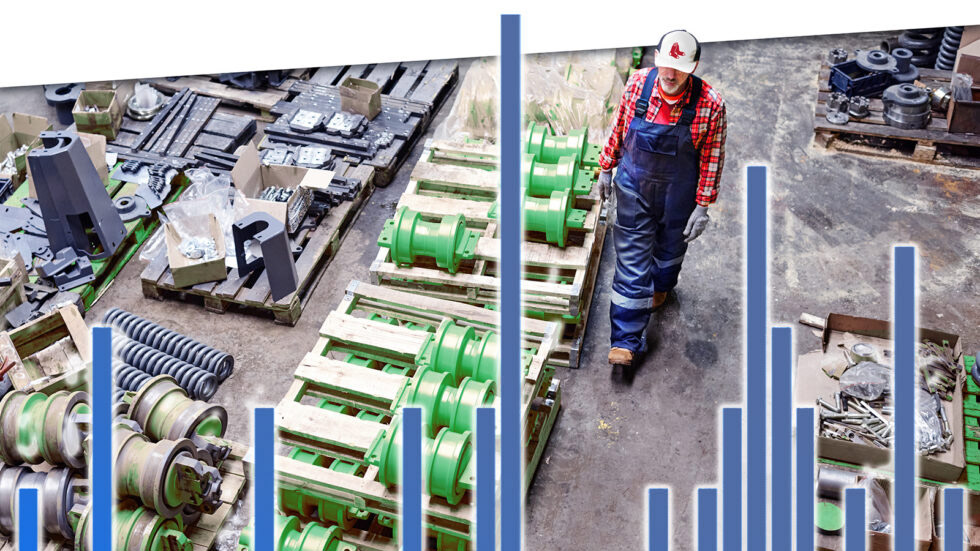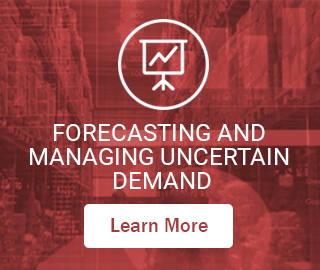Smart Inventory Planning & Optimization to be Showcased at Epicor Insights
Belmont, Mass., May 14 – Smart Software, Inc., provider of industry-leading demand forecasting, planning, and inventory optimization solutions, today announced that Epicor Software will present Epicor Smart IP&O, a joint solution for inventory planning, forecasting, and optimization at Epicor’s annual customer conference in Nashville, TN from May 21 – 24 . Smart Software will also be on hand to profile the solution in booth # 5 in the Solutions Pavilion.
Smart Software and Epicor’s collaboration brings the cloud-based Smart IP&O (Inventory Planning and Optimization) into the latest version of the Epicor enterprise resource planning (ERP) solution. Smart Software’s Chief Technology Officer, Sree Menon states “it’s no longer enough to simply manage inventory. By seamlessly integrating strategic planning with operational execution, Smart IP&O enables Epicor ERP users to continuously predict, respond and plan inventory helping lower costs and improve service.”
The Epicor Sales Engineering team will demonstrate Epicor Smart IP&O in two sessions:
“Introducing Epicor Smart Demand Planning & Inventory Optimization”
Thursday, May 24 at 8:00 AM
Tennessee Ballrom B
“Moderniza las Operaciones de tu Cadena de Suministro con la Plataforma Epicor Smart Inventory Planning and Optimization”
Thursday, May 24 at 10:20 AM
Ryman Studio H/I
Epicor Insights 2018 will bring together more than 3,000 users of Epicor’s industry-specific ERP solutions for the manufacturing, distribution, and service industries. Customers who attend will have dedicated education tracks focused on their specific products and solutions, plus more opportunities to network across products and industries. To learn more, visit https://www.epicor.com/customers/insights/default.aspx
About Smart Software, Inc.
Founded in 1981, Smart Software, Inc. is a leader in providing businesses with enterprise-wide demand forecasting, planning and inventory optimization solutions. Smart Software’s demand forecasting and inventory optimization solutions have helped thousands of users worldwide, including customers at mid-market enterprises and Fortune 500 companies, such as Mitsubishi, Siemens, Disney, FedEx, MARS, and The Home Depot. Smart Inventory Planning & Optimization gives demand planners the tools to handle sales seasonality, promotions, new and aging products, multi-dimensional hierarchies, and intermittently demanded service parts and capital goods items. It also provides inventory managers with accurate estimates of the optimal inventory and safety stock required to meet future orders and achieve desired service levels. Smart Software is headquartered in Belmont, Massachusetts and can be found on the World Wide Web at www.smartcorp.com.
For more information, please contact Smart Software, Inc., Four Hill Road, Belmont, MA 02478.
Phone: 1-800-SMART-99 (800-762-7899); FAX: 1-617-489-2748; E-mail: info@smartcorp.com
Smart Software VP of Research to Present at ISF 2018
Dr. Tom Willemain to lead ISF session on Time Series Dissaggregation
Belmont, Mass., May 14, 2018 – Smart Software, Inc., provider of industry-leading demand forecasting, planning, and inventory optimization solutions, today announced that Tom Willemain, vice president for research, will present at the International Symposium of Forecasting from June 17 – 20 in Boulder, CO.
Dr. Willemain, will present a tutorial on Time Series Dissaggregation and how the approaches he’ll outline can improve the quality of demand forecasts. Imagine that you must provide daily forecast results but can only obtain historical demand at monthly or weekly levels. Often times, granular demand data is not available. How do you proceed? Converting aggregate quarterly, monthly, or weekly data to daily data is example of the time series dissaggregation problem. Dr. Willemain will discuss current solutions to this problem and press an improved solution.
As the premier, international forecasting conference, the ISF provides the opportunity to interact with the world’s leading forecasting researchers and practitioners. The attendance is large enough so that the best in the field are attracted, yet small enough that you are able to meet and discuss one-on-one. The ISF offers a variety of networking opportunities, through keynote speaker presentations, academic sessions, workshops, meals, and social programs. In addition, representatives of leading publishing, software, and other related companies are on hand to discuss their most recent offerings.
About Dr. Thomas Willemain
Dr. Thomas Reed Willemain served as an Expert Statistical Consultant to the National Security Agency (NSA) at Ft. Meade, MD and as a member of the Adjunct Research Staff at an affiliated think-tank, the Institute for Defense Analyses Center for Computing Sciences (IDA/CCS). He is Professor Emeritus of Industrial and Systems Engineering at Rensselaer Polytechnic Institute, having previously held faculty positions at Harvard’s Kennedy School of Government and Massachusetts Institute of Technology. He is also co-founder and Senior Vice President/Research at Smart Software, Inc. He is a member of the Association of Former Intelligence Officers, the Military Operations Research Society, the American Statistical Association, and several other professional organizations. Willemain received the BSE degree (summa cum laude, Phi Beta Kappa) from Princeton University and the MS and PhD degrees from Massachusetts Institute of Technology. His other books include: Statistical Methods for Planners, Emergency Medical Systems Analysis (with R. C. Larson), and 80 articles in peer-reviewed journals on topics in statistics, operations research, health care and other topics. For more information, email: TomW@SmartCorp.com or visit www.TomWillemain.com.
About Smart Software, Inc.
Founded in 1981, Smart Software, Inc. is a leader in providing businesses with enterprise-wide demand forecasting, planning and inventory optimization solutions. Smart Software’s demand forecasting and inventory optimization solutions have helped thousands of users worldwide, including customers at mid-market enterprises and Fortune 500 companies, such as Mitsubishi, Siemens, Disney, FedEx, MARS, and The Home Depot. Smart Inventory Planning & Optimization gives demand planners the tools to handle sales seasonality, promotions, new and aging products, multi-dimensional hierarchies, and intermittently demanded service parts and capital goods items. It also provides inventory managers with accurate estimates of the optimal inventory and safety stock required to meet future orders and achieve desired service levels. Smart Software is headquartered in Belmont, Massachusetts and can be found at www.smartcorp.com
SmartForecasts is a registered trademark of Smart Software, Inc. All other trademarks are the property of their respective owners.
For more information, please contact Smart Software, Inc., Four Hill Road, Belmont, MA 02478.
Phone: 1-800-SMART-99 (800-762-7899); FAX: 1-617-489-2748; E-mail: info@smartcorp.com
Leading Indicators can Foreshadow Demand
Most statistical forecasting works in one direct flow from past data to forecast. Forecasting with leading indicators works a different way. A leading indicator is a second variable that may influence the one being forecasted. Applying testable human knowledge about the predictive power in the relationship between these different sets of data will sometimes provide superior accuracy.
Most of the time, a forecast is based solely on the past history of the item being forecast. Let’s assume that the forecaster’s problem is to predict future unit sales of an important product. The process begins with gathering data on the product’s past sales. (Gregory Hartunian shares some practical advice on choosing the best available data in a previous post to the Smart Forecaster.) This data flows into forecasting software, which analyzes the sales record to measure the level of random variability and exploit any predictable aspects, such as trend or regular patterns of seasonal variability. The forecast is based entirely on the past behavior of the item being forecasted. Nothing that might have caused the wiggles and jiggles in the product’s sales graph is explicitly accounted for. This approach is fast, simple, self-contained and scalable, because software can zip through a huge number of forecasts automatically.
But sometimes the forecaster can do better, at the cost of more work. If the forecaster can peer through the fog of randomness and identify a second variable that influences the one being forecasted, a leading indicator, more accurate predictions are possible.
For example, suppose the product is window glass for houses. It may well be that increases or decreases in the number of construction permits for new houses will be reflected in corresponding increases or decreases in the number of sheets of glass ordered several months later. If the forecaster can distill this “lagged” or delayed relationship into an equation, that equation can be used to forecast glass sales several months hence using known values of the leading indicator. This equation is called a “regression equation” and has a form something like:
Sales of glass in 3 months = 210.9 + 26.7 × Number of housing starts this month.
Forecasting software can take the housing start and glass sales data and convert them into such a regression equation.
Graph displaying a relationship between example figures for time-shifted building permits and demand for glass
Leading indicators demonstrated
However, unlike automatic statistical forecasting based on a product’s past sales, forecasting with a leading indicator faces the same problem as the proverbial recipe for rabbit stew: “First catch a rabbit”. Here the forecaster’s subject matter expertise is critical to success. The forecaster must be able to nominate one or more candidates for the job of leading indicator. After this crucial step, based on the forecaster’s knowledge, experience and intuition, then software can be used to verify that there really is a predictive, time-delayed relationship between the candidate leading indicator and the variable to be forecasted.
This verification step is done using a “cross-correlation” analysis. The software essentially takes as input a sequence of values of the variable to be forecasted and another sequence of values of the supposed leading indicator. Then it slides the data from the forecast variable ahead by, successively, one, two, three, etc. time periods. At each slip in time (called a “lag”, because the leading indicator is lagging further and further behind the forecast variable), the software checks for a pattern of association between the two variables. If it finds a pattern that is too strong to be explained as a statistical accident, the forecaster’s hunch is confirmed.
Obviously, forecasting with leading indicators is more work than forecasting using only an item’s own past values. The forecaster has to identify a leading indicator, starting with a list suggested by the forecaster’s subject matter expertise. This is a “hand-crafting” process that is not suited to mass production of forecasts. But it can be a successful approach for a smaller number of important items that are worth the extra effort. The role of forecasting software, such as our SmartForecasts system, is to help the forecaster authenticate the leading indicator and then exploit it.
Thomas Willemain, PhD, co-founded Smart Software and currently serves as Senior Vice President for Research. Dr. Willemain also serves as Professor Emeritus of Industrial and Systems Engineering at Rensselaer Polytechnic Institute and as a member of the research staff at the Center for Computing Sciences, Institute for Defense Analyses.


In almost every business and industry, decision-makers need reliable forecasts of critical variables, such as sales, revenues, product demand, inventory levels, market share, expenses, and industry trends.Many kinds of people make these forecasts. Some are sophisticated technical analysts such as business economists and statisticians. Many others regard forecasting as an important part of their overall work: general managers, production planners, inventory control specialists, financial analysts, strategic planners, market researchers, and product and sales managers. Still, others seldom think of themselves as forecasters but often have to make forecasts on an intuitive, judgmental basis.

In a highly configurable manufacturing environment, forecasting finished goods can become a complex and daunting task. The number of possible finished products will skyrocket when many components are interchangeable. A traditional MRP would force us to forecast every single finished product which can be unrealistic or even impossible. Several leading ERP solutions introduce the concept of the “Planning BOM”, which allows the use of forecasts at a higher level in the manufacturing process. In this article, we will discuss this functionality in ERP, and how you can take advantage of it with Smart Inventory Planning and Optimization (Smart IP&O) to get ahead of your demand in the face of this complexity.

True or false: The forecast doesn’t matter to spare parts inventory management. At first glance, this statement seems obviously false. After all, forecasts are crucial for planning stock levels, right? It depends on what you mean by a “forecast”. If you mean an old-school single-number forecast (“demand for item CX218b will be 3 units next week and 6 units the week after”), then no. If you broaden the meaning of forecast to include a probability distribution taking account of uncertainties in both demand and supply, then yes.
Forecasting With the Right Data
In order to reap the efficiency benefits of forecasting, you need the most accurate forecasts—forecasts built on the most appropriate historical data. Most discussions of this issue tend to focus on the merits of using demand vs. shipment history—and I’ll comment on this later. But first, let’s talk about the use of net vs. gross data.
Net vs. Gross History
Many planners are inclined to use net sales data to create their forecasts. Systems that track sales capture transactions as they occur and aggregate results into weekly or monthly periodic totals. In some cases, sales records account for returned purchases as negative sales and compute a net total. These net figures, which often mask real sales patterns, are fed into the forecasting system. The historical data used actually presents a false sense of what the customer wanted, and when they wanted it. This will carry forward into the forecast, with less than optimal results.
(more…)















